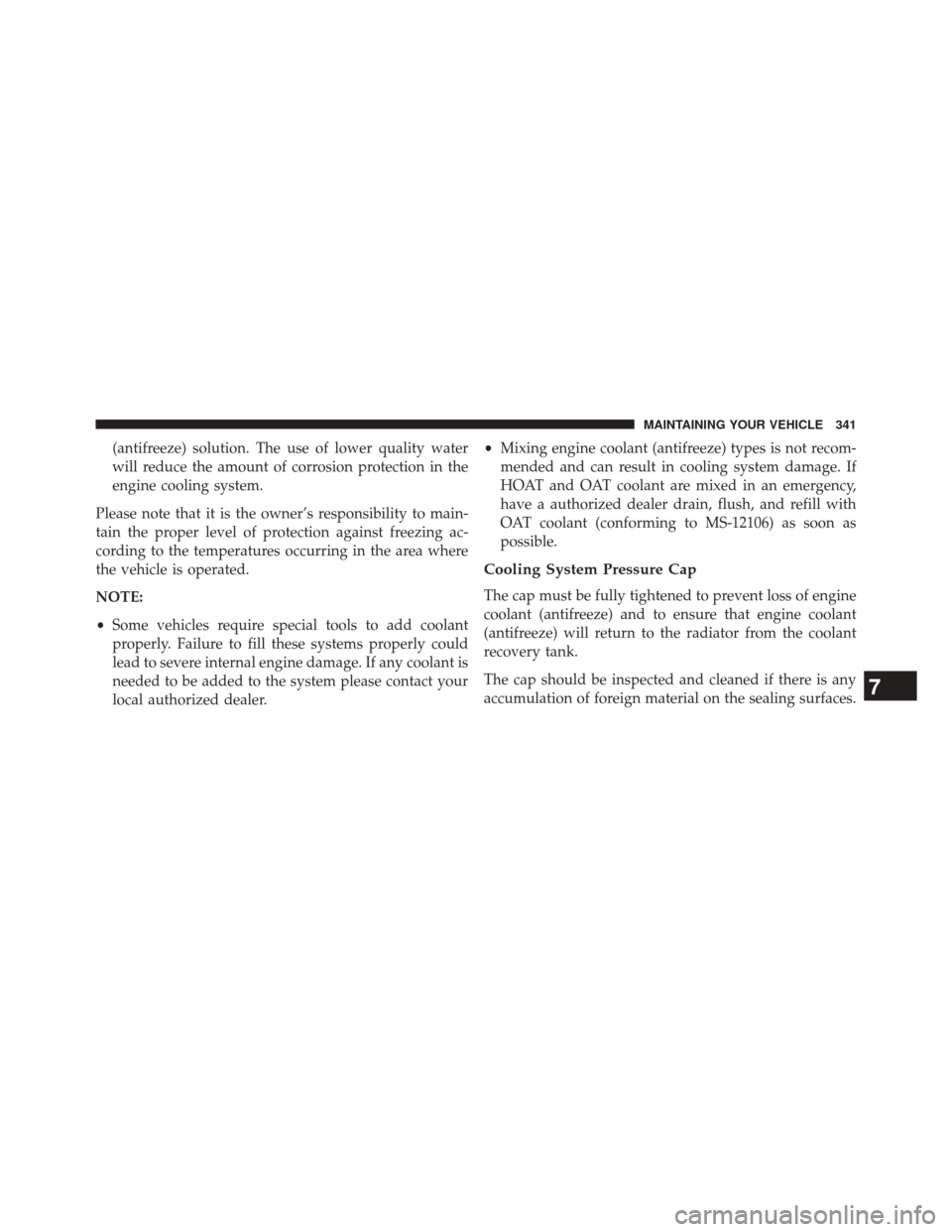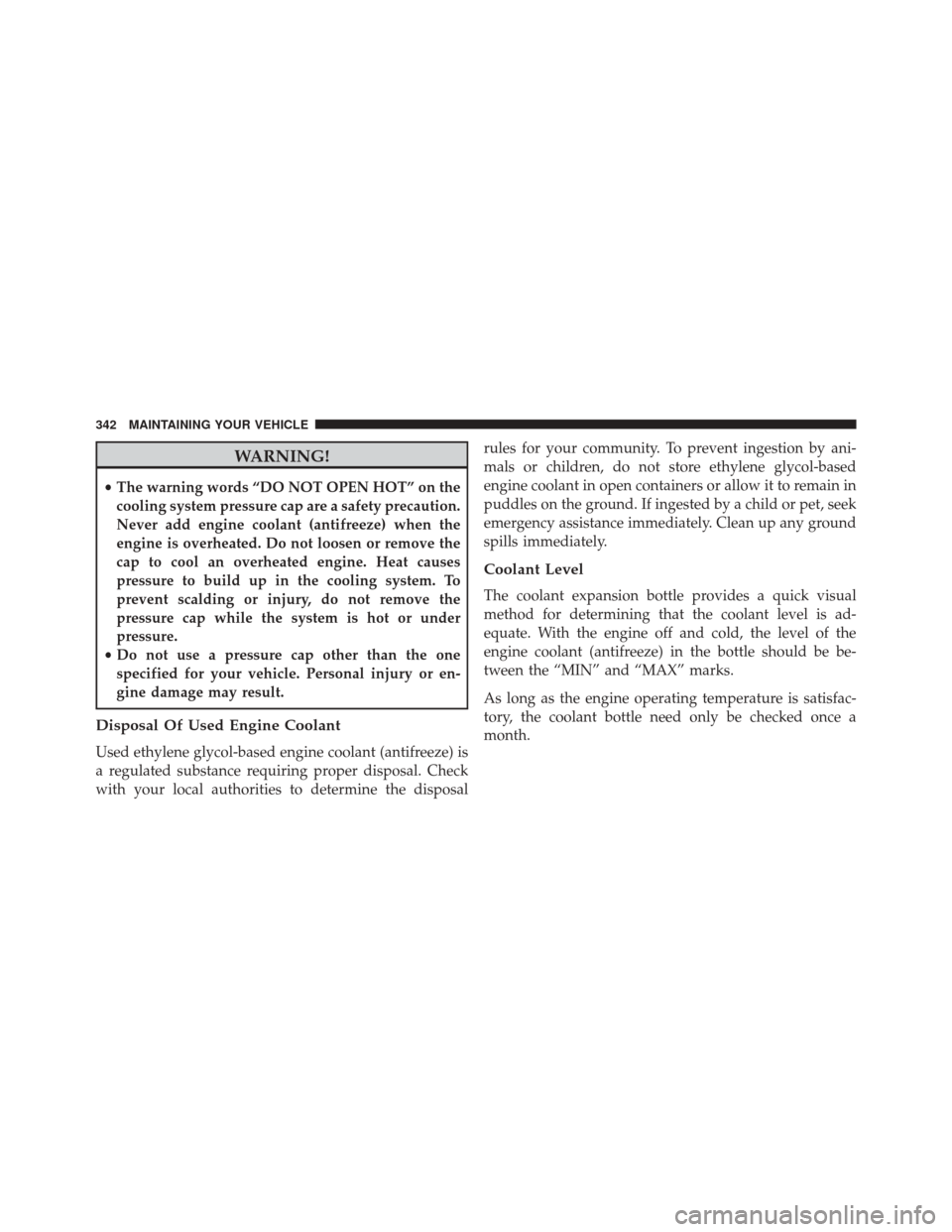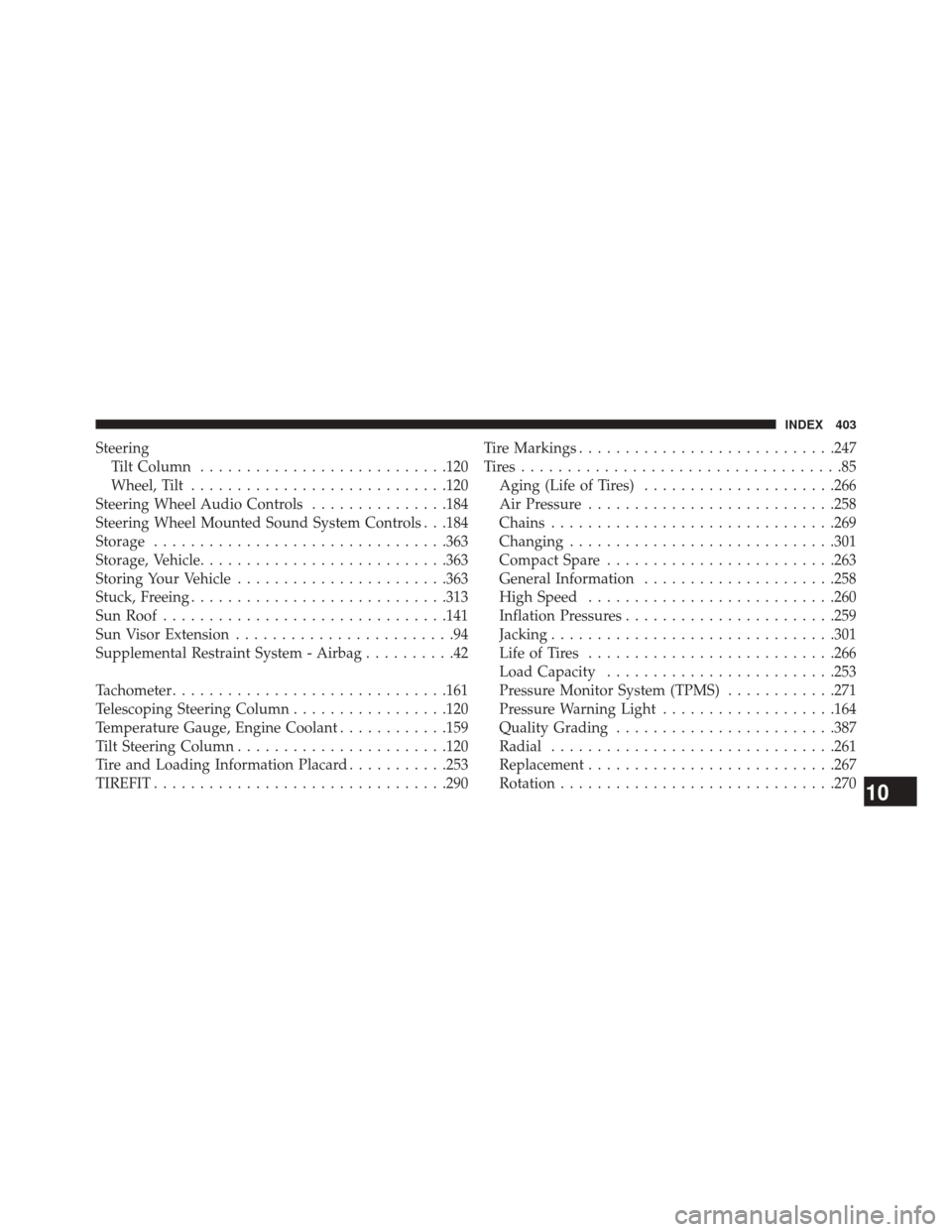Page 343 of 409

(antifreeze) solution. The use of lower quality water
will reduce the amount of corrosion protection in the
engine cooling system.
Please note that it is the owner’s responsibility to main-
tain the proper level of protection against freezing ac-
cording to the temperatures occurring in the area where
the vehicle is operated.
NOTE:
• Some vehicles require special tools to add coolant
properly. Failure to fill these systems properly could
lead to severe internal engine damage. If any coolant is
needed to be added to the system please contact your
local authorized dealer. •
Mixing engine coolant (antifreeze) types is not recom-
mended and can result in cooling system damage. If
HOAT and OAT coolant are mixed in an emergency,
have a authorized dealer drain, flush, and refill with
OAT coolant (conforming to MS-12106) as soon as
possible.
Cooling System Pressure Cap
The cap must be fully tightened to prevent loss of engine
coolant (antifreeze) and to ensure that engine coolant
(antifreeze) will return to the radiator from the coolant
recovery tank.
The cap should be inspected and cleaned if there is any
accumulation of foreign material on the sealing surfaces.
7
MAINTAINING YOUR VEHICLE 341
Page 344 of 409

WARNING!
•The warning words “DO NOT OPEN HOT” on the
cooling system pressure cap are a safety precaution.
Never add engine coolant (antifreeze) when the
engine is overheated. Do not loosen or remove the
cap to cool an overheated engine. Heat causes
pressure to build up in the cooling system. To
prevent scalding or injury, do not remove the
pressure cap while the system is hot or under
pressure.
• Do not use a pressure cap other than the one
specified for your vehicle. Personal injury or en-
gine damage may result.
Disposal Of Used Engine Coolant
Used ethylene glycol-based engine coolant (antifreeze) is
a regulated substance requiring proper disposal. Check
with your local authorities to determine the disposal rules for your community. To prevent ingestion by ani-
mals or children, do not store ethylene glycol-based
engine coolant in open containers or allow it to remain in
puddles on the ground. If ingested by a child or pet, seek
emergency assistance immediately. Clean up any ground
spills immediately.
Coolant Level
The coolant expansion bottle provides a quick visual
method for determining that the coolant level is ad-
equate. With the engine off and cold, the level of the
engine coolant (antifreeze) in the bottle should be be-
tween the “MIN” and “MAX” marks.
As long as the engine operating temperature is satisfac-
tory, the coolant bottle need only be checked once a
month.
342 MAINTAINING YOUR VEHICLE
Page 346 of 409

result in unsatisfactory engine coolant (antifreeze)
performance, poor gas mileage, and increased emis-
sions.
Brake System
In order to assure brake system performance, all brake
system components should be inspected periodically.
Refer to the “Maintenance Schedule” for the proper
maintenance intervals.
WARNING!
Riding the brakes can lead to brake failure and
possibly a collision. Driving with your foot resting or
riding on the brake pedal can result in abnormally
high brake temperatures, excessive lining wear, and
possible brake damage. Riding the brakes may also
reduce braking capacity in an emergency.
Brake Master Cylinder
The fluid level in the master cylinder should be checked
when performing under hood services, or immediately if
the “Brake Warning Light” is on.
Be sure to clean the top of the master cylinder area before
removing the cap. If necessary, add fluid to bring the
fluid level up to the requirements described on the brake
fluid reservoir. Fluid level can be expected to fall as the
brake pads wear. The brake fluid level should be checked
when the pads are replaced. However, low fluid level
may be caused by a leak and a checkup may be needed.
344 MAINTAINING YOUR VEHICLE
Page 399 of 409

Octane Rating......................... .277
Requirements ......................... .277
Tank Capacity ......................... .369
Fueling ............................... .280
Fuses ................................. .355
Garage Door Opener (HomeLink®) ............133
Gasoline, Clean Air ....................... .277
Gasoline (Fuel) .......................... .277
Gasoline, Reformulated .....................277
Gauges Coolant Temperature .....................159
Fuel ................................ .159
Odometer ............................ .166
Tachometer ........................... .161
Gear Ranges ............................ .220
Gear Select Lever Override ..................315
General Information ...................... .276
General Maintenance ...................... .166Glass Cleaning
.......................... .354
Hazard Driving Through Flowing, Rising, or Shallow
Standing Water ........................ .232
Headlights ..............................110
Cleaning ............................ .353
High Beam ........................... .161
Passing ..............................111
Heated Mirrors ............................93
Hill Start Assist .......................... .240
Holder, Cup ............................ .146
HomeLink® (Garage Door Opener) ............133
Hood Release ........................... .108
Ignition Key..................................12
Immobilizer (Sentry Key) ....................13
Infant Restraint ...........................61
10
INDEX 397
Page 405 of 409

SteeringTilt Column .......................... .120
Wheel, Tilt ........................... .120
Steering Wheel Audio Controls ...............184
Steering Wheel Mounted Sound System Controls . . .184
Storage ............................... .363
Storage, Vehicle .......................... .363
Storing Your Vehicle ...................... .363
Stuck, Freeing ........................... .313
Sun Roof .............................. .141
Sun Visor Extension ........................94
Supplemental Restraint System - Airbag ..........42
Tachometer ............................. .161
Telescoping Steering Column .................120
Temperature Gauge, Engine Coolant ............159
Tilt Steering Column ...................... .120
Tire and Loading Information Placard ...........253
TIREFIT ............................... .290Tire Markings
........................... .247
Tires...................................85 Aging (Life of Tires) .....................266
Air Pressure .......................... .258
Chains .............................. .269
Changing ............................ .301
Compact Spare ........................ .263
General Information .....................258
High Speed .......................... .260
Inflation Pressures ...................... .259
Jacking .............................. .301
Life of Tires .......................... .266
Load Capacity ........................ .253
Pressure Monitor System (TPMS) ............271
Pressure Warning Light ...................164
Quality Grading ....................... .387
Radial .............................. .261
Replacement .......................... .267
Rotation ............................. .270
10
INDEX 403